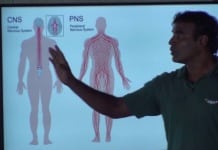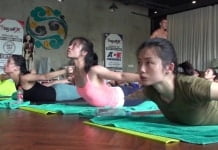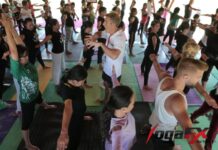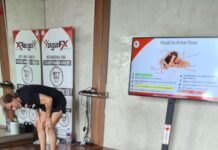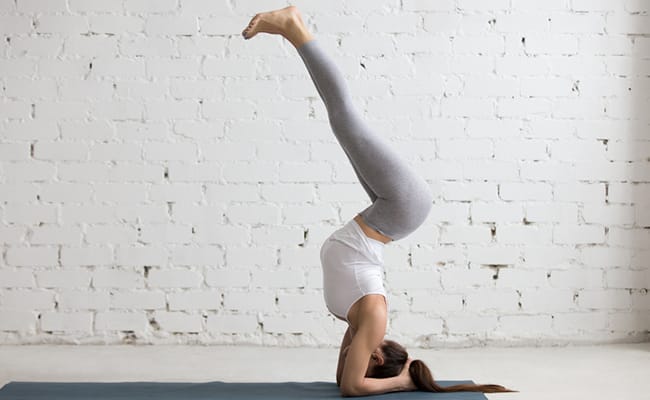
When life feels overwhelming, enjoy a literal change in perspective by turning your world upside down and practicing a yoga inversion.
What are Inversions?
Inversion yoga is any pose in which the heart is higher than the head. In many cases, the feet will also be higher than the head. All inversions include a literal change in perspective, flipping the body upside down for important mental and physical health benefits.
Inversions positions range from a restorative legs-up-the-wall pose to a more physically intense handstand ✅
For decades, yoga practitioners with daily inversion practice have reported better sleep, improved focus, and enhanced digestion. While scientific studies have yet to prove these benefits, research does show that an inversion practice can positively impact the mind and body.
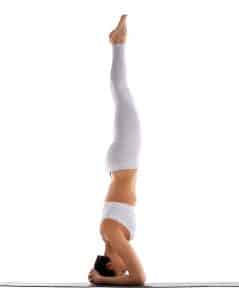
Inversion Health Benefits
The “Upanishads”, one of the oldest yoga texts, states, “One, who practices headstand three hours daily, conquers time”.
Ancient yogis believed that one who practices inversions daily could defy time and live forever! While inversions may not make you immortal, they do offer many important health benefits for the body.?♀️
Inversions influence four major systems in the body: the cardiovascular, the lymphatic, the nervous, and the endocrine.
Cardiovascular
Turning the body upside down delivers fresh, oxygenated blood to the head, improving circulation. Standing upright for the majority of the day causes lower lung tissues to become saturated with blood.
Inverting helps ventilate the upper lungs, which improves oxygen-to-blood exchange and promotes healthier tissue. Being upside down also helps lower blood pressure and heart rate, thereby reducing stress.
Lymphatic
The lymphatic system is responsible for waste removal, fluid balance, and immune system balance; it’s the “sewage system” for the body. Like the circulatory system, the lymphatic system benefits from muscular movement to stimulate flow.
Turning the body upside down stimulates the entire lymphatic system. Even mild inversions such as a “feet up the wall” pose will stimulate the lymphatic system, which in turn strengthens the immune system and may decrease the incidence of minor and allergies.
Endocrine
Many inversions stimulate the pituitary gland, the body’s master control gland, and also promote the release of endorphins for an enhanced state of well-being.
Nervous
Inversions stimulate the cerebrospinal fluid (also known as CSF), the “juice” of the central nervous system. Headstand position, for example, promotes elasticity in the cranial bones.
Inversions may also help relieve the pain the in back. Years of sitting hunched over a desk or standing with poor posture lead to chronic back pain. Practicing inversions, especially with the use of an inversion table, may help improve the alignment of the musculoskeletal system.
This includes strengthening the ligaments and soft tissues, relieving muscle spasms, and improving spinal disc health.
Incorporating inversions into your daily yoga practice
Inversions like handstand, headstand, and forearm balance are some of the most advanced yoga poses. An inversion like Practice Yoga Inversions (headstand) is said to revitalize the entire body and stimulate the mind.
Inversions reverse the pull of gravity on the organs, including the stomach, intestines, and reproductive system.
When properly executed, a headstand is said to help cleanse the intestines and overcome liver and stomach problems. Headstand supports proper spinal alignment, gently massages the internal organs, and may help reduce anxiety.
Some health conditions, however, make it unsafe to practice more advanced inversions like headstand. High blood pressure, glaucoma, detached retina, cardiovascular disease, slipped discs, or cervical spondylitis.
If you are new to inversions, kicking up into a headstand in the middle of the room may seem overwhelming in a studio environment.
How to incorporate inversions into your yoga practice
✅Strengthen your core and arms by practicing dolphin pose. Dolphin pose helps relieve fatigue and headaches. First, position yourself in the downward-facing dog. Next, shift your arms into a plank pose while keeping your rear body elevated in the downward-facing dog.
Walk your feet in towards your hands. Keep your chest broad and shoulders positioned over your elbows. Practice dolphin for 10 to 20 breaths, then takes a break in child pose to recover.
✅Practice headstand next to a wall. Place the yoga mat against the wall. Kneel with your hands intertwined in front of you. Place the top of your head in front of your hands and then lift your knees.
You’ll be in a modified version of a downward-facing dog with your hands intertwined and elbows on the floor. Just like with dolphins, walk your feet in towards your body.
For a supported headstand, kick one leg up towards the wall and bring the other one up behind you. Rest your legs against the wall and point the top of your feet towards the ceiling.
✅Build your strength. To build your strength in the headstand, practice kicking up in a controlled manner. If possible, move on foot several feet away from the wall, followed by the other.
This will strengthen your core. With practice, you’ll be strong enough to kick up into a headstand from your yoga mat in the middle of the room ❗
Join Our Yoga Teacher Training And Main Event








